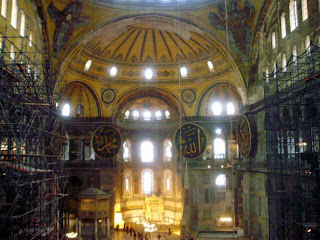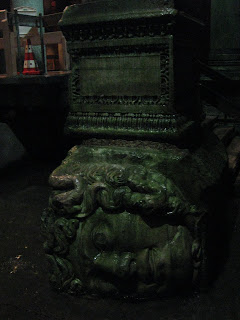After a morning at the Blue Mosque, Hagia Sophia, and Roman Cisterns, we spent our afternoon at
Topkapi Palace (try saying that 5 times fast because I could barely get it out 1 time slowly). The palace grounds are made up of many beautiful buildings which have all been converted into various museums. The museums were full of interesting exhibits and artifacts. There were lots of jewels, pottery, clothing from the Ottoman empire, and many other things. I even saw Moses’ cane, John the Baptist’s skull and forearm (or what’s left of it), and Abraham’s pot. Or at least that’s what the plaques told me I saw and I wanted to believe. Unfortunately there were no pictures allowed. Luckily I could take the pictures of the gorgeous grounds and views from the grounds along with some of the intricately decorated rooms on display. I’ve already decided that my first home will be full of Turkish tiling.
Outside the palace entrance
palace entrance
view of the Bosphorus
We affectionately referred to our second morning in Istanbul as our “bazaar” morning (it makes more sense when you say it out loud). Istanbul is famous for its enormous bazaars packed with thousands of vendors who sell everything from Prada wallets to pashminas to evil eye earings. And, of course, pottery. Lots and lots and lots of pottery. It is literally a maze of brightly lit and decorated corridors that make it easy to get sucked into shopping and not so easy to get out.
So we started with the biggest and the most famous: the Grand Bazaar. It was quite an experience. Aggressive sales techniques were at their peak and we had fun navigating the practice of haggling with vendors. We all bought plenty to pack our suitcases full.
one of the many entrances
The following morning we visited Istanbul's other famous bazaar: the Spice Bazaar. At this point, we were shopped out and our suitcases were packed to the brim, so we did much more browsing than buying. But, it was once again an experience.


























